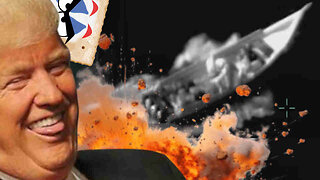Premium Only Content

World War One - Dates & Timeline Pt. 1 In Colour Film - Catastrophe
World War I Pitted Germany, Austria-Hungary and the Ottoman Empire against Great Britain, the United States, France, Russia, Italy and Japan. New military technology resulted in unprecedented carnage. By the time the war was over and the Allied Powers claimed victory, more than 16 million people—soldiers and civilians alike—were dead. Pt. 1 of Seven.
1. It was a global war
Over 30 nations declared war between 1914 and 1918. The majority joined on the side of the Allies, including Serbia, Russia, France, Britain, Italy and the United States. They were opposed by Germany, Austria-Hungary, Bulgaria and the Ottoman Empire, who together formed the Central Powers. What began as a relatively small conflict in southeast Europe became a war between European empires. Britain and its Empire’s entry into the war made this a truly global conflict fought on a geographical scale never seen before. Fighting occurred not only on the Western Front, but in eastern and southeast Europe, Africa and the Middle East.
2. It is Far Better to Face the Bullets...
The First World War was not inevitable or accidental, but began as a result of human actions and decisions.
Over 65 million men volunteered or were conscripted to fight in mass citizen armies. Millions of civilians also contributed to the war effort by working in industry, agriculture or jobs left open when men enlisted. Victory depended on popular support. Some nations were forced to surrender as their people, pushed to their physical and emotional limits, lost the will to continue fighting. The First World War was also a war against people. Invading armies committed atrocities against civilians in the areas they occupied. Attacks on civilians became increasingly common as each nation tried to break their opponents’ home morale and diminish popular support for the war. Propaganda demonised entire nations and attacked the ‘national characters’ of enemy peoples.
3. It was a war of production
National resources were mobilised as each combatant nation raced to supply its armed forces with enough men and equipment.
In Britain, early failures in munitions manufacturing led to full government intervention in war production. These controls helped its industry produce nearly 4 million rifles, 250,000 machine guns, 52,000 aeroplanes, 2,800 tanks, 25,000 artillery pieces and over 170 million rounds of artillery shells by 1918.
4. It was a war of innovation
Advances in weaponry and military technology provoked tactical changes as each side tried to gain an advantage over the other. The introduction of aircraft into war left soldiers and civilians vulnerable to attacks from above for the first time.
Major innovations were also made in manufacturing, chemistry and communications. Medical advances made the First World War the first major conflict in which British deaths in battle outnumbered deaths caused by disease.
5. It was a war of destruction
The First World War left an estimated 16 million soldiers and civilians dead and countless others physically and psychologically wounded. The war also forever altered the world’s social and political landscape. It accelerated changes in attitudes towards gender and class and led to the collapse of the Russian, Austro-Hungarian and Ottoman empires. The cost of waging total war - and of rebuilding afterwards - ravaged the national economies of both the victorious European Allies and the defeated Central Powers.
The human cost of the First World War for Britain saw the creation of a new language of remembrance, which remains to this day. It can be seen in war memorials in cities, towns, schools, places of worship and workplaces, as well as in rituals such as Remembrance Sunday and the two-minute silence at 11am each 11 November.
World War I Begins
At the dawn of the 20th century, few anticipated a global war, but what came to be known as the Great War began on June 28, 1914, with the assassinations of Austrian Archduke Franz Ferdinand and his wife, Sophie, while they were visiting Sarajevo, Bosnia, a country recently annexed into the Austrian Empire. Many Bosnians and their Serbian neighbors resented this foreign rule and the Archduke’s visit to Sarajevo provided the opportunity for a small band of Serbian dissidents to strike back. Austria responded to the assassinations by teaming up with its ally, Germany, and declaring war on Serbia. The conflict soon involved Russia, France and Belgium. Fearful of a full-scale world war that would threaten its sea routes to other countries, Great Britain joined the fight against Germany and Austria.
Each country believed the fighting would last only a few months. Nations were categorized either as Central Powers or Allies. Countries that joined the Central Powers, such as Bulgaria and the Ottoman Empire, supported Austria-Hungary and Germany. The Allies were Russia, France, Belgium and Great Britain, but they were later joined by Japan, Romania, China and the United States.
No Man’s Land: Trench Warfare
During World War I, trench warfare was a defensive military tactic used extensively by both sides, allowing soldiers some protection from enemy fire but also hindering troops from readily advancing and thus prolonging the war. Trench warfare was the major combat tactic in France and Belgium. Trenches were often dug up to 12 feet deep and stretched for miles. For stability, some trenches included wooden beams and/or sandbags. Even during lulls in the fighting, death occurred almost daily in the trenches due to a sniper’s bullet or the unsanitary living conditions which resulted in many diseases such as dysentery, typhus and cholera. Other diseases caused by the poor conditions were trench mouth and trench foot*.
*Trench mouth was an infection of the mouth due to overgrowth of certain oral bacteria. The condition was made worse by poor oral hygiene, smoking, malnutrition and psychological stress. To prevent trench foot, a fungal disease caused by exposure to wet and cold, soldiers frequently added wooden planks in the trenches to keep from having to stand in water.
Barbed wire and explosive mines—as well as bullets and grenades—were essential weapons used to hinder infantry advances across “No Man’s Land,” the bleak landscape between the trenches of the opposing sides.
New offensive weapons were implemented during the war including tanks and poison gases*.
*Tanks, armored against artillery fire, were capable of rolling over barbed wire as well as crossing treacherous terrain.
Chlorine was one of the poisonous gases used in World War I. It was damaging to the eyes, nose, throat and lungs, and produced symptoms ranging from irritation to blindness and death.)
In 1915, the Germans used poison gases against the Allies fighting in the trenches on the Western Front. To protect soldiers from chemical warfare, gas masks were developed. Great Britain made one of the first types of masks capable of minimizing the deadly impact of these gases on their troops.
Though considered a novelty when the war began, aircraft were used by both sides for reconnaissance, allowing personnel to observe enemy troop positions, to direct artillery fire and to photograph enemy lines. By the end of the war, the concepts of aerial combat and aerial bombing had come into being.
1871 - Following the defeat of France in the Franco-Prussian War, Germany is unified as an Imperial federation of states, led by the King of Prussia (Kaiser Wilhelm I). This spurs a new era of population growth and rapid industrialization. The Germans also forcibly annex the provinces of Alsace and Lorraine from France.
1882 - Germany, Austria-Hungary (Hapsburg Empire) and Italy form the Triple Alliance.
1891 - The Russian Empire and France form their own alliance in reaction to the Triple Alliance.
1898 - Germany begins to build up its navy to challenge the British Navy's long-standing global supremacy.
January 1902 - Britain and Japan form a naval alliance.
April 1904 - The British reach a strategic agreement with France which includes mutual military support in the event of war.
January 1905 - Troops of Russian Czar Nicholas II fire upon peaceful demonstrators in St. Petersburg killing hundreds in what comes to be known as Bloody Sunday.
May 1905 - Russia suffers a military defeat at sea by newly industrialized Japan, thwarting Russia's territorial ambitions toward Manchuria and Korea.
October 1905 - Continuing political unrest in Russia, including a general strike, results in the creation of a national legislative assembly (Duma) by the Czar.
February 1906 - H.M.S. Dreadnought is launched by Britain, marking the advent of a new class of big-gun battleships. The Germans follow suit and begin building similar battleships as an all-out arms race ensues between Germany and Britain.
August 1907 - The British reach a strategic agreement with Russia.
October 1908 - Austria-Hungary, backed by Germany, annexes Bosnia-Herzegovina. Neighboring Serbia, with the backing of Russia, voices its objection in support of the Serbian minority living in Bosnia.
March 1909 - Germany forces Russia to endorse the annexation of Bosnia-Herzegovina by Austria-Hungary.
1910 - Germany surpasses Britain as the leading manufacturing nation in Europe. The United States remains the world leader, surpassing all of the European manufacturing nations combined.
October 1912 - The Balkan War erupts in southern Europe as Serbia leads an attack by members of the Balkan League (Serbia, Bulgaria and Greece) against the Ottoman (Turkish) Empire to drive the Turks out of Europe.
May 1913 - The Balkan War ends with the Turks driven out of southern Europe. A peace settlement is then drawn up by the major European powers that divides up the former Turkish areas in southern Europe among the Balkan League nations. However, the peace is short-lived as Bulgaria, desiring a bigger share, attacks neighboring Greece and Serbia. Romania then attacks Bulgaria along with the Turks. This Second Balkan War results in Bulgaria losing territory and the Serbians becoming emboldened, leaving the Balkan region of southern Europe politically unstable.
1914
June 28, 1914 - Archduke Franz Ferdinand, heir to the Austrian throne, and his wife, visit Sarajevo in Bosnia. A bomb is thrown at their auto but misses. Undaunted, they continue their visit only to be shot and killed a short time later by a lone assassin. Believing the assassin to be a Serbian nationalist, the Austrians target their anger toward Serbia.
July 23, 1914 - Austria-Hungary, with the backing of Germany, delivers an ultimatum to Serbia. The Serbs propose arbitration as a way to resolve dispute, but also begin mobilization of their troops.
July 25, 1914 - Austria-Hungary severs diplomatic ties with Serbia and begins to mobilize its troops.
July 26, 1914 - Britain attempts to organize a political conference among the major European powers to resolve the dispute between Austria-Hungary and Serbia. France and Italy agree to participate. Russia then agrees, but Germany refuses.
July 28, 1914 - The Austro-Hungarian Empire declares war on Serbia.
July 29, 1914 - Britain calls for international mediation to resolve the worsening crisis. Russia urges German restraint, but the Russians begin partial troop mobilization as a precaution. The Germans then warn Russia on its mobilization and begin to mobilize themselves.
July 30, 1914 - Austrian warships bombard Belgrade, capital of Serbia.
July 31, 1914 - Reacting to the Austrian attack on Serbia, Russia begins full mobilization of its troops. Germany demands that it stop.
August 1, 1914 - Germany declares war on Russia. France and Belgium begin full mobilization.
August 3, 1914 - Germany declares war on France, and invades neutral Belgium. Britain then sends an ultimatum, rejected by the Germans, to withdraw from Belgium.
August 4, 1914 - Great Britain declares war on Germany. The declaration is binding on all Dominions within the British Empire including Canada, Australia, New Zealand, India and South Africa.
August 4, 1914 - The United States declares its neutrality.
August 4-16, 1914 - The Siege of Liege occurs as Germans attack the Belgian fortress city but meet resistance from Belgian troops inside the Liege Forts. The twelve forts surrounding the city are then bombarded into submission by German and Austrian howitzers using high explosive shells. Remaining Belgian troops then retreat northward toward Antwerp as the German westward advance continues.
August 6, 1914 - The Austro-Hungarian Empire declares war on Russia.
August 6, 1914 - French and British troops invade the German colony of Togo in West Africa. Twenty days later, the German governor there surrenders.
August 7, 1914 - The first British troops land in France. The 120,000 highly trained members of the regular British Army form the British Expeditionary Force (BEF) commanded by Field Marshal John French.
August 7-24, 1914 - The French desire to score a quick victory ignites the first major French-German action of the war. The French Army invades Alsace and Lorraine according to their master strategy known as Plan XVII. However, the French offensive is met by effective German counter-attacks using heavy artillery and machine-guns. The French suffer heavy casualties including 27,000 soldiers killed in a single day, the worst one-day death toll in the history of the French Army. The French then fall back toward Paris amid 300,000 total casualties.
August 8, 1914 - Britain enacts the Defense of the Realm Act (DORA) granting unprecedented powers to the government to control the economy and daily life.
August 12, 1914 - Great Britain and France declare war on Austria-Hungary. Serbia is invaded by Austria-Hungary.
August 17, 1914 - Russia invades Germany, attacking into East Prussia, forcing the outnumbered Germans there to fall back. This marks the advent of the Eastern Front in Europe in which Russia will oppose Germany and Austria-Hungary.
August 20, 1914 - German troops occupy undefended Brussels, capital of Belgium. Following this, the main German armies continue westward and invade France according to their master strategy known as the Schlieffen Plan. It calls for a giant counter-clockwise movement of German armies wheeling into France, swallowing up Paris, and then attacking the rear of the French armies concentrated in the Alsace-Lorraine area. Under the overall command of Helmuth von Moltke, Chief of the German General Staff, the Germans seek to achieve victory over France within six weeks and then focus on defeating Russia in the East before Russia's six-million-man army, the world's largest, can fully mobilize.
August 23, 1914 - Japan declares war on Germany. The Japanese then prepare to assist the British in expelling the Germans from the Far East. German possessions in the South Pacific include a naval base on the coast of China, part of New Guinea, Samoa, and the Caroline, Marshall and Mariana Islands.
Battle of Tannenberg
August 26, 1914 - On the Eastern Front, German troops in East Prussia under the new command of Paul von Hindenburg and Erich Ludendorff oppose the Russian 2nd Army. Aided by aerial reconnaissance and the interception of uncoded Russian radio messages, the Germans effectively reposition their troops to counter the initial Russian advance. Five days later, after surrounding the Russians, the battle ends with a German victory and the capture of 125,000 Russians. Following this success, the Germans drive the Russians out of East Prussia with heavy casualties. The impressive victory elevates Hindenburg and Ludendorff to the status of heroes in Germany.
August 30, 1914 - German possessions in the Far East are attacked as New Zealand troops occupy German Samoa. Three days later, Japanese forces land on the coast of China, preparing to attack the German naval base at Tsingtao (Qingdao). A month later, the Japanese begin their occupation of the Caroline, Marshall and Mariana Islands.
Battle of the Marne
September 5-12, 1914 - On the Western Front, Paris is saved as French and British troops disrupt the Schlieffen Plan by launching a major counter-offensive against the invading German armies to the east of Paris. Six hundred taxi cabs from the city help to move French troops to the Front. Aided by French aerial reconnaissance which reveals a gap has developed in the center of the whole German advance, the French and British exploit this weakness and press their advantage. The Germans then begin a strategic withdrawal northward as the Allies pursue. Each side repeatedly tries to outmaneuver the other and gain a tactical advantage as they move northward in what becomes known as the Race to the Sea.
September 7, 1914 - In the Far East, a German naval squadron, commanded by Graf von Spee severs the British Pacific communications cable.
September 8, 1914 - The French government enacts nationwide State of War regulations which include total control over the economy and national security, strict censorship, and suspension of civil liberties.
September 17, 1914 - On the Eastern Front, Austrian forces steadily retreat from the advancing Russian 3rd and 8th armies fighting in southern Poland and along the Russian-Austrian border. The Germans then send the newly formed 9th Army to halt the Russians. This marks the beginning of a pattern in which the Germans will aid the weaker Austro-Hungarian Army.
September 22, 1914 - The first-ever British air raid against Germany occurs as Zeppelin bases at Cologne and Düsseldorf are bombed.
First Battle of Ypres
October 19-November 22, 1914
October 19, 1914 - Still hoping to score a quick victory in the West, the Germans launch a major attack on Ypres in Belgium. Despite heavy losses, British, French and Belgian troops fend off the attack and the Germans do not break through. During the battle, the Germans send waves of inexperienced 17 to 20-year-old volunteer soldiers, some fresh out of school. They advance shoulder-to-shoulder while singing patriotic songs only to be systematically gunned down in what the Germans themselves later call the "massacre of the innocents." By November, overall casualties will total 250,000 men, including nearly half of the British Regular Army.
October 29, 1914 - The Ottoman Empire (Turkey) enters the war on the side of the Germans as three warships shell the Russian port of Odessa. Three days later, Russia declares war on Turkey. Russian and Turkish troops then prepare for battle along the common border of the Russian Caucasus and the Ottoman Empire.
October-November, 1914 - Germans and Austrians launch a combined offensive against the Russians on the Eastern Front. The German 9th Army targets Warsaw, Poland, but is opposed by six Russian armies and withdraws. The Austrians attack the Russians in Galicia (a province in northeast Austria) with indecisive results. However, the Russians fail to press their advantage at Warsaw and instead begin a split counter-offensive moving both southward against the Austrians in Galicia and northward toward Germany. The German 9th Army then regroups and cuts off the Russians at Lodz, Poland, halting their advance and forcing an eastward withdrawal by the Russians.
November 1, 1914 - Austria invades Serbia. This is the third attempt to conquer the Serbs in retaliation for the assassination of Archduke Franz Ferdinand. This attempt fails like the two before it, at the hands of highly motivated Serbs fighting on their home ground. The Austrians withdraw in mid-December, after suffering over 220,000 casualties from the three failed invasions.
November 1, 1914 - The British Navy suffers its worst defeat in centuries during a sea battle in the Pacific. Two British ships, the Monmouth and Good Hope, are sunk with no survivors by a German squadron commanded by Admiral Graf von Spee.
November 3, 1914 - Kaiser Wilhelm appoints Erich von Falkenhayn as the new Chief of the German General Staff, replacing Helmuth von Moltke who is sacked due to the failure of the Schlieffen Plan.
November 5, 1914 - France and Britain declare war on the Ottoman (Turkish) Empire.
November 6, 1914 - In the Persian Gulf, a major British offensive begins as the 6th Indian Division invades Mesopotamia. The objective is to protect the oil pipeline from Persia. Two weeks later they capture the city of Basra.
November 7, 1914 - In the Far East, the German naval base at Tsingtao is captured by the Japanese, aided by a British and Indian battalion.
Trench Warfare Begins
December 1914 - The Western Front in Europe stabilizes in the aftermath of the First Battle of Ypres as the Germans go on the defensive and transfer troops to the East to fight the Russians. The 450-mile-long Western Front stretches from the Channel Coast southward through Belgium and Eastern France into Switzerland. Troops from both sides construct opposing trench fortifications and dugouts protected by barbed wire, machine-gun nests, snipers, and mortars, with an in-between area called No Man's Land. The Eastern Front also sees its share of trenches as troops dig in after the Russians hold off the Germans in Poland and the Austrians hold off the Russians at Limanowa. The 600-mile Eastern Front stretches from the Baltic Sea southward through East Prussia and Austria to the Carpathian Mountains.
December 8, 1914 - The Battle of Falkland Islands occurs as British Navy warships destroy the German squadron of Admiral Graf von Spee in the South Atlantic off the coast of Argentina. Von Spee and two sons serving in his squadron are killed.
December 10, 1914 - The French begin a series of attacks along the Western Front against the Germans in the Artois region of northern France and Champagne in the south. Hampered by a lack of heavy artillery and muddy winter conditions, the French fail to make any significant gains and both offensives are soon suspended.
December 16, 1914 - Britain suffers its first civilian casualties at home in the war as the German Navy bombards the coastal towns of Whitby, Hartlepool and Scarborough, killing 40 persons and wounding hundreds.
December 25, 1914 - A Christmas truce occurs between German and British soldiers in the trenches of northern France. All shooting stops as the soldiers exit their trenches, exchange gifts, sing carols and engage in a soccer game. This is the only Christmas truce of the war, as Allied commanders subsequently forbid fraternization with orders to shoot any violators.
January 17, 1915 - The initial Turkish offensive into Russia is thwarted as the Turkish 3rd Army suffers a defeat by the Russian Army of the Caucasus near Kars. The Russians then begin a multi-pronged invasion of the Ottoman Empire from the Caucasus.
January 19, 1915 - Germany begins an aerial bombing campaign against Britain using Zeppelins.
January 31, 1915 - Poison gas is used for the first time in the war as Germans on the Eastern Front attack Russian positions west of Warsaw. Although the Germans fire 18,000 gas shells, they have little effect on the Russians as frigid temperatures prevent the gas from vaporizing.
February 1915 - The Turks begin forced deportations of Armenians. Over the next two years, an estimated 1.5 million Armenians will either starve to death, die of thirst in the Syrian Desert, or be murdered by Turkish troops and bandits, during the Armenian Genocide.
February 3, 1915 - Turkish troops launch an unsuccessful attack against the British-controlled Suez Canal, which is regularly used by the British to ferry Dominion troops from Australia, New Zealand and India to European battle grounds.
February 4, 1915 - Germany declares the waters surrounding British Isles to be a war zone in which ships can be sunk without warning.
February 7-22, 1915 - On the Eastern Front in Europe, the German 8th and 10th Armies wage a successful offensive against the Russian 10th Army in the Masurian Lakes region of East Prussia, pushing the Russians eastward into the Augustow Forest where they are decimated.
February 16, 1915 - On the Western Front, the French launch their second offensive against German defense lines in Champagne. Once again they are hampered by the muddy winter weather and a lack of heavy artillery. After a month of fighting, suffering 240,000 casualties, the exhausted French break off the offensive.
U-Boat Warfare Begins
February 18, 1915 - The first German U-Boat campaign of the war begins with unrestricted attacks against merchant and passenger ships in the waters around the British Isles. Within six months, Allied shipping losses at sea surpass the number of new ships being built. However, the unrestricted attacks also arouse the anger of the neutral United States as Americans are killed.
March 1915 - The British Navy imposes a total sea blockade on Germany, prohibiting all shipping imports including food.
March 10, 1915 - British and Indian troops in the Artois region of northern France attack the Germans around the village of Neuve Chapelle. The attack takes the outnumbered Germans by surprise. The British achieve their initial objective but fail to capitalize on the narrow breach they create in the German lines. After three days of fighting, with over 11,000 casualties, the British offensive is suspended. The Germans suffer over 10,000 casualties.
March 22, 1915 - The Russians capture 120,000 Austrians at Przemysl in Galicia. This marks the culmination of a series of winter battles between the Austrians and Russians to secure the strategic Carpathian Mountain passes and opens the way for a Russian invasion of Hungary. Realizing this, the Germans and Austrians make plans to combine their troops and launch a major spring offensive.
April 11, 1915 - British troops in Mesopotamia fend off a large attack by the Turks against Basra. The British then branch out to protect their position at Basra, and proceed up the Tigris Valley toward Baghdad.
Second Battle of Ypres
April 22-May 25, 1915
April 22, 1915 - Poison gas is used for the first time on the Western Front as the German 4th Army attacks French positions around Ypres in northern Belgium. As they attack, the Germans release chlorine gas from over 5,000 cylinders forming poisonous green clouds that drift toward two French African divisions. Lacking any protection, the French quickly retreat. Although this creates a five-mile-wide gap in the Allied lines, the Germans fail to capitalize due to a lack of reserve troops and cautious frontline troops hesitant to venture too close to the gas clouds. British and Canadians then plug the gap but are unable to regain any ground taken by the Germans. The British then withdraw to a second line of defense, leaving Ypres in Allied hands but virtually surrounded. Casualties in the Second Battle of Ypres total 58,000 Allies and 38,000 Germans.
April 25, 1915 - Allied troops land on the Gallipoli Peninsula in an attempt to unblock the Dardanelles Straits near Constantinople (present day Istanbul, Turkey) to reopen access to Russia through the Black Sea. The landing comes after a failed attempt by British and French warships to force their way through the narrow Straits. The 70,000 landing troops include 15,000 Australians and New Zealanders. The peninsula is heavily defended by Turkish troops, supplied and trained by Germans. Within two weeks, a stalemate develops as the Allies fail to gain any of their objectives and the Turks begin a series of costly attacks attempting to drive out the Allies.
May 1, 1915 - German U-Boats sink their first American merchant ship, the tanker Gulflight, in the Mediterranean Sea near Sicily.
May 2, 1915 - On the Eastern Front, a combined Austro-German offensive begins against the Russian 3rd Army at Tarnow and Gorlice in Galicia. The attack is preceded by a massive artillery bombardment with over 700,000 shells. This breaks down the defenses of the weakened Russians who now suffer from shortages of artillery shells and rifles. Within two days, the Austro-Germans break through the lines and the Russians begin a disorganized retreat.
Lusitania Sunk
May 7, 1915 - A German U-Boat torpedoes the British passenger liner Lusitania off the Irish coast. It sinks in 18 minutes, drowning 1,201 persons, including 128 Americans. President Woodrow Wilson subsequently sends four diplomatic protests to Germany.
May 9, 1915 - Following six days of artillery bombardment by over a thousand French guns, the French 10th Army attacks German defense lines in the Artois, advancing toward Vimy Ridge. The French achieve their initial objective, but fail to capitalize on the narrow breach they create in the German lines. The next day, Germans counter-attack and push back the French.
May 9, 1915 - Complementing the French offensive at Vimy, British and Indian troops launch their second attack against the Germans around Neuve Chapelle in the Artois. However, without sufficient artillery support to weaken the German frontline defenses, the advancing soldiers are decimated by German machine-gun fire. The attack is called off the next day with 11,000 casualties.
May 15, 1915 - British and Indian troops launch another attack against Germans in the Artois, this time at Festubert, north of Neuve Chapelle. The attack is preceded by a 60-hour artillery bombardment. But the troops advance just 1,000 yards while suffering 16,000 casualties.
May 23, 1915 - Italy enters the war on the side of the Allies by declaring war on Austria-Hungary. The Italians then launch offensives along the 400-mile common border between Austria and Italy. The better equipped Austrians take advantage of the mountainous terrain to establish strong defensive positions all along the border. The Italians then focus their attacks on the mountain passes at Trentino and the valley of the Isonzo River.
May 31, 1915 - The first aerial bombing of London occurs as German Zeppelins kill 28 persons.
June 12, 1915 - After pausing to regroup, Austro-German troops resume their offensive in Galicia on the Eastern Front. Within five days, they break through the Russian lines and push the Russian 3rd and 8th Armies further eastward. Russian casualties soon surpass 400,000.
June 16, 1915 - The French 10th Army launches its second attempt to seize Vimy Ridge from the Germans in the Artois. This time the troops encounter an intensive artillery bombardment from the improved defenses of the German 6th Army. The French achieve their initial objective, but then succumb to a German counter-attack, just as they did in the first attempt at Vimy. The French call off the Vimy offensive with 100,000 casualties. The Germans suffer 60,000.
June 23, 1915 - The First Battle of Isonzo begins as Italian troops attack Austrian defenses. Initial gains by the Italians are soon repulsed by the Austrians with heavy casualties for both sides. Three additional battles are fought through the end of 1915 with similar results, totaling 230,000 casualties for the Italians and 165,000 for the Austrians.
July 1, 1915 - Russia creates a Central War Industries Committee to oversee production and address a severe shortage of artillery shells and rifles on the Front. Russian soldiers in the field without rifles can only get them from fellow soldiers after they are killed or wounded.
July 9, 1915 - In Africa, the German Southwest Africa colony (present day Namibia) is taken by the Allies following 11 months of fighting between the Germans and South African and Rhodesian troops loyal to the British.
July 13, 1915 - On the Eastern Front, the next phase of the combined Austro-German offensive against the Russians begins in northern Poland, with the Austro-Germans advancing toward Warsaw. The Russian Army now gets weaker by the day due to chronic supply shortages and declining morale. Once again, the Russians retreat, and also order a total civilian evacuation of Poland. This results in great hardship for the people as they leave their homes and head eastward, clogging the roads and hampering the movement of Russian troops.
August 1, 1915 - The Fokker Scourge begins over the Western Front as German pilots achieve air supremacy using the highly effective Fokker monoplane featuring a synchronized machine-gun that fires bullets through the spinning propeller. Although the technology was pioneered by French pilot Roland Garros, the Germans copied and improved the synchronized gun idea after capturing his plane. The Fokker Scourge will last nearly a year, until Allied aerial technology catches up.
August 5, 1915 - Warsaw is taken by Austro-Germans troops. This ends a century of Russian control of the city. After taking Warsaw, the Austro-Germans move on to capture Ivangorod, Kovno, Brest-Litovsk, Bialystok, Grodno, and Vilna. By the end of September, Russian troops are driven out of Poland and Galicia, back to the original lines from which they had begun the war in 1914. For the time being, the battered Russian Army has effectively been eliminated as an offensive threat on the Eastern Front, freeing the Germans to focus more effort on the Western Front.
August 6, 1915 - Hoping to break the stalemate at Gallipoli, British renew the offensive. An additional 20,000 troops are landed but their attack is hampered by poor communications and logistical problems. The Turks, led by Mustafa Kemal, respond by rushing in two divisions and the British offensive fails.
September 5, 1915 - Russian Czar Nicholas II takes personal command of the Russian Army, hoping to rally his faltering troops. Losses to the Czar's army from the Austro-German offensives in Galicia and Poland include over 1,400,000 casualties and 750,000 captured. Russia is also weakened economically by the loss of Poland's industrial and agricultural output. Additionally, the ongoing mass exodus of Russian troops and civilians from Poland, called the Great Retreat, spurs dangerous political and social unrest in Russia, undermining the rule of the Czar and his Imperial government.
September 6, 1915 - Bulgaria enters the war on Germany's side with an eye toward invading neighboring Serbia. Thus far in the war, Austria-Hungary has tried, but failed, three times to conquer Serbia in retaliation for the assassination of Archduke Ferdinand. Now, the Austrians, aided by Germany and Bulgaria, plan to try again. With the addition of Bulgaria, Germany now has three allies in the war including Austria-Hungary and Turkey. This alliance is called the Central Powers due to their geographic location, primarily in central Europe.
September 18, 1915 - The Germans announce an end to their first U-Boat campaign, begun in February, which had targeted ships around the British Isles. This comes in response to increasing protests from the United States following American civilian deaths at sea. The U-Boats are then sent by the Germans to wreak havoc in the Mediterranean Sea, away from American shipping lanes in the Atlantic.
September 25, 1915 - On the Western Front, the British use poison gas for the first time as they launch an attack against the German 6th Army in the Artois. Chlorine gas is released from over 5,000 cylinders, creating a poisonous cloud that drifts toward the Germans, opening a gap in their front line. The British advance and quickly seize their objective, the town of Loos, but then fail to capitalize on the four-mile-wide breach in the German lines. The Germans regroup and when the British resume the attack the next day they are mowed down in the hundreds by well-placed German machine-gunners. In all, the British suffer 50,000 casualties during the Loos offensive. British Army Commander John French is then sacked, replaced by Douglas Haig.
September 25, 1915 - The French 2nd Army in Champagne attacks the weakest part of the German lines, creating a six-mile-wide breach that is three miles deep. The German 3rd Army then rushes in reinforcements, regroups its defense lines and plugs the gap. Facing strong resistance, the French break off the attack.
September 26, 1915 - The French launch their third attempt to seize Vimy Ridge from the Germans in Artois, and this time they secure the ridge.
September 26-28, 1915 - In the Middle East, a British victory occurs at the Battle of Kut al-Amara in Mesopotamia as they defeat the Turks. The resounding victory spurs an ambitious move by the British to venture onward to quickly capture Baghdad. However, that attempt fails and the troops return to Kut-al-Amara and dig in.
October 6, 1915 - The invasion of Serbia begins as Austro-German troops attack from the north. Five days later, the Bulgarians attack from the east. The outnumbered Serbs have their poorly supplied troops stretched too thinly to defend both fronts. Belgrade then falls to the Germans and the Bulgarians capture Kumanova, severing the country's north-south rail line. This leaves the overwhelmed Serbian troops no option other than to retreat westward through the mountains into Albania.
December 5, 1915 - Hoping to overcome their earlier defeat at Kut al-Amara in Mesopotamia, Turkish troops lay siege to the town, surrounding the British garrison there, cutting them off completely.
December 19, 1915 - The Allies begin an orderly evacuation of the Gallipoli Peninsula. This comes after months of stalemate in which Turkish troops contained all breakthrough attempts while inflicting 250,000 casualties. The British Navy successfully evacuates 83,000 survivors by sea as the Turks watch without firing a shot, glad to see them leave.
January 1916 - President Woodrow Wilson begins an effort to organize a peace conference in Europe.
February 18, 1916 - In West Africa, the German colony of Cameroon falls to the French and British following 17 months of fighting. This leaves only one German colony remaining in Africa, known as German East Africa. There, 10,000 troops skillfully commanded by General Paul von Lettow-Vorbeck prove to be an elusive but deadly target, as they are pursued by a British-led force ten times larger.
Battle of Verdun
February 21-December 18, 1916
February 21, 1916 - On the Western Front, the German 5th Army attacks the French 2nd Army north of the historic city of Verdun, following a nine-hour artillery bombardment. The Germans under Chief of the General Staff, Erich Falkenhayn, seek to "bleed" the French Army to death by targeting the cherished city. At first, the Germans make rapid gains along the east bank of the Meuse River, overrunning bombed out French trenches, and capture lightly defended Fort Douaumont four days later without firing a shot. However, the German offensive soon stalls as the French rush in massive reinforcements and strengthen their defenses, under the new command of Henri Petain, who is determined to save Verdun. An early spring thaw also turns the entire battlefield into mud, hampering offensive maneuvers.
March 6, 1916 - Germans renew their Verdun offensive, this time attacking along the west bank of the Meuse River, targeting two strategic hills northwest of Verdun that form the main French position. However, by the end of March, the heavily defended hills are only partially in German hands.
March 18, 1916 - On the Eastern Front, the Russians oblige a French request to wage an offensive to divert German resources from Verdun. Although the Russians greatly outnumber the Germans in the northern sector of the Eastern Front, their poorly coordinated offensive around Vilna and at Lake Naroch is swiftly defeated by the Germans with 70,000 Russian casualties.
April 9, 1916 - The Germans attack again at Verdun, now along a 20-mile-wide front on both the east and west banks of the Meuse River. Once again the attack only yields partial gains in the face of stiff French resistance.
April 18, 1916 - President Woodrow Wilson threatens to sever diplomatic ties between the United States and Germany following the sinking of the passenger ferry Sussex by a U-Boat in the English Channel. The attack marked the beginning of a new U-Boat campaign around the British Isles. But in response to Wilson, the Germans call off the U-Boats.
April 29, 1916 - In the Middle East, the five-month siege at Kut-al-Amara in Mesopotamia ends as 13,000 British and Indian soldiers, now on the verge of starvation, surrender to the Turks. The largest-ever surrender by the British Army comes after four failed attempts by British relief troops to break through to the surrounded garrison.
May 3, 1916 - At Verdun, the Germans begin another attack on the west bank of the Meuse. This time they gain the advantage and within three days capture the two French hills they had been striving for since early March, thus achieving a solid position northwest of Verdun.
May 15, 1916 - Austrian troops attack Italian mountain positions in the Trentino. The Italians withdraw southward, forcing the Austrians to stretch their supply lines over the difficult terrain. The arrival of Italian reinforcements and a successful counter-attack then halts the Austrian offensive completely.
May 25, 1916 - The era of the all-volunteer British Army ends as universal conscription takes effect requiring all eligible British men between the ages of 19 and 40 to report, excluding men working in agriculture, mining or the railroads.
Battle of Jutland
May 31, 1916 - The main German and British naval fleets clash in the Battle of Jutland in the North Sea, as both sides try, but fail, to score a decisive victory. Forward battle cruisers from the British Grand Fleet are initially lured southward toward the German High Seas Fleet, but then turn completely around, luring the entire German fleet northward. As they get near, the British blast away at the German forward ships. The Germans return fire and the two fleets fire furiously at each other. However, the Germans, aware they are outgunned by the larger British fleet, disengage by abruptly turning away. In the dead of the night the Germans withdraw entirely. The British do not risk a pursuit and instead head home. Both sides claim victory. Although the Germans sink 14 of the 151 British ships while losing 11 of 99 ships, the British Navy retains its dominance of the North Sea and the naval blockade of Germany will remain intact for the war's duration.
June 1, 1916 - Germans at Verdun try to continue their offensive success along the Meuse River and now attack the French on the east bank, targeting Fort Vaux and the fortification at Thiaumont. Eight days later, both objectives are taken as the French suffer heavy casualties. The Germans now push onward toward a ridge that overlooks Verdun and edge toward the Meuse bridges. The entire nation of France now rallies behind their troops in the defense of Verdun as French generals vow it will not be taken.
June 4, 1916 - Four Russian armies on the Eastern Front, under their innovative new commander, General Alexei Brusilov, begin a general offensive in the southwest along a 300-mile front. Brusilov avoids the style of predictable narrow frontline attacks used previously, in favor of a sweeping offensive over hundreds of miles that is harder to pin down. Thinly stretched Austro-Hungarian troops defending this portion of the Front are taken by surprise. Realizing their distress, the Germans pull four divisions from Verdun and send them east. By the end of summer, the Germans will send 20 more divisions and merge the surviving Austro-Hungarian troops into the Germany Army.
June 22, 1916 - Germans resume their offensive near Verdun, targeting Fort Souville which overlooks the city and the Meuse bridges. Using poisonous phosgene gas at the start of the attack, they initially take the village of Fleury just two miles north of Verdun, but further advance southward is halted by a strong French counter-attack. Verdun has now become a battle of attrition for both sides with a death toll already approaching 500,000 men.
Battle of the Somme
July 1-November 18, 1916
June 24, 1916 - The Allies begin a week-long artillery bombardment of German defensive positions on the Somme River in northern France, in preparation for a major British-led offensive. Over 1.5 million shells are fired along a 15-mile front to pulverize the intricate German trench system and to blow apart rows of barbed wire protecting the trenches. British Commander Douglas Haig believes this will allow an unhindered infantry advance and a rapid breakthrough of the German Front on the first day of battle.
July 1, 1916 - The British Army suffers the worst single-day death toll in its history as 18,800 soldiers are killed on the first day of the Battle of the Somme. The losses come as 13 attacking divisions encounter German defenses that are still intact despite the seven-day bombardment designed to knock them out. The British also attack in broad daylight, advancing in lines shoulder-to-shoulder only to be systematically mowed down by German machine-gunners. The Somme offensive quickly becomes a battle of attrition as British and French troops make marginal gains against the Germans but repeatedly fail to break through the entire Front as planned.
July 10, 1916 - The Germans attack again at Verdun, using poison gas, and advance toward Fort Souville. Four days later, the French counter-attack and halt the Germans.
July 13, 1916 - The British launch a night attack against German positions along a 3.5-mile portion of the Somme Front. After advancing nearly 1,000 yards, the advance is halted as the Germans regroup their defenses. Two days later, the British once again penetrate the German line and advance to High Wood but are then pushed back.
August 27, 1916 - Romania declares war on the Central Powers and begins an invasion of Austria-Hungary through the Carpathian Mountains. The Romanians face little opposition initially and advance 50 miles into Transylvania.
August 28, 1916 - Kaiser Wilhelm appoints Field Marshal Paul von Hindenburg as Germany's new Chief of the General Staff, replacing Erich Falkenhayn following the disappointment at Verdun and recent setbacks on the Eastern Front.
August 28, 1916 - Italy declares war on Germany, thus expanding the scope of its military activities beyond the Italian-Austrian Front.
August 29, 1916 - Germany's entire economy is placed under the Hindenburg Plan allowing the military to exercise dictatorial-style powers to control the labor force, munitions production, food distribution and most aspects of daily life.
September 1, 1916 - Romania is invaded by the newly formed Danube Army, consisting of Germans, Turks and Bulgarians under the command of German General August von Mackensen. This marks the start of a multi-pronged invasion of Romania in response to its aggression against Austria-Hungary.
September 15, 1916 - The first-ever appearance of tanks on a battlefield occurs as British troops renew the Somme offensive and attack German positions along a five-mile front, advancing 2,000 yards with tank support. The British-developed tanks feature two small side-cannons and four machine-guns, operated by an eight-man crew. As the infantry advances, individual tanks provide support by blasting and rolling over the German barbed wire, piercing the frontline defense, and then roll along the length of the trench, raking the German soldiers with machine-gun fire.
September 20, 1916 - On the Eastern Front, the Brusilov Offensive grinds to a halt. Since its launch in early June, four Russian armies under the command of General Alexei Brusilov had swept eastward up to 60 miles deep along a 300-mile front while capturing 350,000 Austro-Hungarian troops. But by the end of summer, the Germans brought in 24 divisions from the Western Front and placed the surviving Austro-Hungarian troops under German command. The Russian attack withered after the loss of nearly a million men amid insufficient reserves. The humiliating withdrawal from the hard-won areas wrecks Russian troop morale, fueling political and social unrest in Russia.
September 25, 1916 - British and French troops renew their attacks in the Somme, capturing several villages north of the Somme River, including Thiepval, where the British successfully use tanks again. Following these successes, however, heavy rain turns the entire battlefield to mud, preventing effective maneuvers.
October 8, 1916 - The German Air Force (Luftstreikrafte) is founded as various aerial fighting groups are merged.
October 10, 1916 - Romanian troops return home after being pushed out of Hungary by two Austro-German armies. The Austro-German 9th Army then invades Romania and heads toward Bucharest.
October 24, 1916 - At Verdun, the French under General Robert Nivelle, begin an ambitious offensive designed to end the German threat there by targeting Fort Douaumont and other German-occupied sites on the east bank of the Meuse River. The attack is preceded by the heaviest artillery bombardment to-date by the French. Additionally, French infantry use an effective new tactic in which they slowly advance in stages, step-by-step behind encroaching waves of artillery fire. Using this creeping barrage tactic, they seize Fort Douaumont, then take Fort Vaux further east, nine days later.
November 7, 1916 - American voters re-elect President Woodrow Wilson who had campaigned on the slogan, "He kept us out of war."
November 13, 1916 - British troops stage a surprise attack and capture the towns of Beaumont Hamel and Beaucourt at the northern end of the Somme Front.
November 18, 1916 - The Battle of the Somme ends upon the first snowfall as the British and French decide to cease the offensive. By now, the Germans have been pushed back just a few miles along the entire 15-mile front, but the major breakthrough the Allies had planned never occurred. Both sides each suffered over 600,000 casualties during the five-month battle. Among the injured German soldiers is Corporal Adolf Hitler, wounded by shrapnel.
November 20, 1916 - Emperor Franz Joseph of Austria-Hungary dies at age 86. He is succeeded by Archduke Charles who wants to take Austria-Hungary out of the war.
December 6, 1916 - Bucharest, capital of Romania, falls to the Austro-Germans. This effectively ends Romanian resistance to the Austro-German invasion and places the country's entire agricultural and industrial resources, including the Ploesti oil fields, in German hands.
December 7, 1916 - LLoyd George becomes Britain's new Prime Minister. His new War Cabinet immediately begins to organize the country for "total war."
December 12, 1916 - Joseph Joffre resigns under pressure from his position as Commander-in-Chief of the French Army, replaced by General Robert Nivelle.
December 15, 1916 - The last offensive in the Battle of Verdun begins as the French push the Germans out of Louvemont and Bezonvaux on the east bank of the Meuse River. Combined with other ground losses, the German withdrawal ends the immediate threat to Verdun and both sides now focus their efforts on battles elsewhere along the Western Front. Overall, the French and Germans suffered nearly a million casualties combined during the ten month battle in which the Germans failed to capture the city of Verdun.
December 18, 1916 - President Woodrow Wilson caps off a year-long effort to organize a peace conference in Europe by asking the combatants to outline their peace terms.
See Part Two - World War One - Dates & Rest Of Timeline Info. Text 1917 Thur 1919 Thanks.
World War One - Dates & Timeline Pt. 1 In Colour Film - Catastrophe
https://rumble.com/v35gtvg-world-war-one-dates-and-timeline-pt.-1-in-colour-film-catastrophe.html
World War One - Dates & Timeline Pt. 2 In Colour Film - Slaughter In The Trenches
World War One - Dates & Timeline Pt. 3 In Colour Film - Blood In The Air
World War One - Dates & Timeline Pt. 4 In Colour Film - Killers Of The Sea
World War One - Dates & Timeline Pt. 5 In Colour Film - Mayhem On The Eastern Front
World War One - Dates & Timeline Pt. 6 In Colour Film - Victory and Despair
World War One - Dates & Timeline Pt. 7 In Colour Film - Tactics And Strategy
Over 65 million men volunteered or were conscripted to fight in mass citizen armies. Millions of civilians also contributed to the war effort by working in industry, agriculture or jobs left open when men enlisted.
https://en.wikipedia.org/wiki/List_of_wars:_1945%E2%80%931989
https://en.wikipedia.org/wiki/List_of_wars:_1990%E2%80%932002
https://en.wikipedia.org/wiki/List_of_wars:_2003%E2%80%93present
https://en.wikipedia.org/wiki/Timeline_of_World_War_I
https://en.wikipedia.org/wiki/List_of_timelines_of_World_War_II
World War I Pitted Germany, Austria-Hungary and the Ottoman Empire against Great Britain, the United States, France, Russia, Italy and Japan. New military technology resulted in unprecedented carnage. By the time the war was over and the Allied Powers claimed victory, more than 16 million people—soldiers and civilians alike—were dead.
-
 1:25:52
1:25:52
What If Everything You Were Taught Was A Lie?
7 days agoAmerica Is Collapsing Today Bible Text Is Not What You Think No Church No Religion No Synagogue
1.65K2 -
 13:07
13:07
Robbi On The Record
3 days ago $5.95 earnedSweet Poison: The Big Fat Lie That’s Killing America
48.3K26 -

Drew Hernandez
11 hours agoEPSTEIN VICTIMS SPEAK OUT & TRUMP DOUBLES DOWN
40.2K37 -
 1:36:41
1:36:41
FreshandFit
7 hours agoWe Are QUITTING YouTube...
57.9K47 -
 2:34:22
2:34:22
TheSaltyCracker
7 hours agoDrug Smugglers Blown Up 9-03-25
101K201 -
 3:12:59
3:12:59
VapinGamers
6 hours ago $1.52 earnedGrim Trials - Game Review/Playthru - Rougelight Dungeon Crawler - !rumbot !music
31K -
 2:47:55
2:47:55
Mally_Mouse
13 hours ago🎮 Let's Play!! -- Jak 2 pt. 16
59.1K2 -
 52:23
52:23
MattMorseTV
8 hours ago $18.60 earned🔴The Cartels are SCREWED.🔴
120K135 -
 1:32:46
1:32:46
Badlands Media
22 hours agoAltered State S3 Ep. 44: Epstein Files, Corrupt Judges, and the College Grift
58.6K2 -
 21:09
21:09
Bearing
19 hours agoAustralian “Racist” Protest EXPLODES 💥 Glowies, Brawls & Media Spin 📣
31.3K43